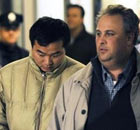Top Biz News
China embarks on journey to manage liquidity
(Xinhua)
Updated: 2010-01-14 10:35
 |
Large Medium Small |
China has moved and is expected to take more steps to rein in excessive money supply, which resulted in rising concerns of inflation and a bubble in the property market, experts say.
The latest move came from the People's Bank of China (PBOC), the central bank, which announced late Tuesday to raise the deposit reserve requirement ratio by 0.5 percentage points from Jan 18 this year, the first increase since June of 2008.
The PBOC has cut the bank reserve requirement ratio (RRR) for four times in the second half of 2008 to stimulate growth as the global financial crisis started to weigh on the economy.
Time to move
"It is time to withdraw some liquidity from the market as there is too much money there", said Zuo Xiaolei, economist with the China Galaxy Securities.
The central bank's decision aimed at mopping up excessive liquidity caused by rising inflow of foreign capital and the country's record bank lending, she added.
China's M2, a broad measure of its money supply, amounted to 59.64 trillion yuan ($8.73 trillion) at the end of November, up 29.74 percent from a year ago, according to the PBOC.
Wang Qing, an economist with Morgan Stanley, said in a report the better-than-expected export performance in December also prompted the hike, signaling a more secure recovery in trade.
China's exports returned to year-on-year growth of 17.7 percent in December, ending a falling streak of 13 months.
The export data indicated a recovery in global demand, which helped reduce the economy's reliance on macro policies to sustain growth and increase the need to tighten, Wang Xiaohui, analyst with Sinolink Securities, said.
He also said that reported surge in bank loans at the beginning of this year pushed the central bank to kick in the measure to control the pace of lending.
Chinese banks made about 600 billion yuan in new loans in the first week of 2010, the Economic Information Daily reported Monday. If bank lending continued the strength, January would see bank credit surpassing one trillion yuan.
Given China's exchange rate regime, RRR adjustments are the most effective liquidity management tool, Wang Qing said.
Rein in credit
"It (the reported rise of bank loans) does not conform to the government's stance on stabilizing lending", Wang Xiaohui said.
Earlier this month, the central bank demanded a moderate growth of loan in 2010 and asked lenders to curb volatility in loaning on fears of inflation and property bubble.
Chinese Premier Wen Jiabao also said in December that the Chinese economy could have been better placed "if our bank lending had been more balanced, better structured and not on such a large scale."
Analysts agreed that the move by the central bank targeted at inflationary expectations, balanced lending, suggesting that policymakers were following through on their pledge to guide credit to prevent inflation and curb soaring home prices.
Wang Zhaoxing, vice chairman of the China Banking Regulatory Commission, said Wednesday that currently loans borrowed by property developers and residents to buy homes accounted for 20 percent of the total new loans. He did not mention the time period.
The government would take more steps if the first quarter credit failed to follow the central bank's guidance, Wang Xiaohui said.
No shift in monetary policy, more flexibility
However, the move did not indicate a shift in the government's "moderately" loose monetary policy, Zuo said. It reflected the flexibility the government vowed in its policies to handle new circumstances in 2010, she said.
The central bank said at its annual work conference that the 2010 monetary policy aimed to sustain a stable and relatively fast rate of economic growth and stabilize prices and effectively manage inflation expectations. It also vowed to add flexibility o fits policy.
Wang Qing said while this RRR hike could help manage inflation expectations, base interest rate hikes will be in response to actual inflation. He also expected more RRR hikes to come.
Nomura International Limited said in a report that it expected a 27 basic points rate hike in as early as February if inflation exceeded 2.2 percent in January.
"We forecast that this will be followed by an additional 54 basic points of rate hikes before the end of 2010 and another 50 basic points RRR hike in the second quarter 2010", the report said.
The report also said the RRR hike did not alter the forecast of China's GDP growth of 12 percent in the first quarter and 10.5 percent for the full year of 2010 as the move was within expectations.













